- Home
- About
- Map
- Trips
- Bringing Boat West
- Migration West
- Solo Motorcycle Ride
- Final Family XC Trip
- Colorado Rockies
- Graduates' XC Trip
- Yosemite & Nevada
- Colorado & Utah
- Best of Utah
- Southern Loop
- Pacific Northwest
- Northern Loop
- Los Angeles to NYC
- East Coast Trips
- 1 Week in Quebec
- Southeast Coast
- NH Backpacking
- Martha's Vineyard
- Canadian Maritimes
- Ocracoke Island
- Edisto Island
- First Landing '02
- Hunting Island '02
- Stowe in Winter
- Hunting Island '01
- Lake Placid
- Chesapeake
- Provincetown
- Hunting Island '00
- Acadia in Winter
- Boston Suburbs
- Niagara Falls
- First Landing '99
- Cape Hatteras
- West Coast Trips
- Utah Off-Roading
- Maui
- Mojave 4WD Course
- Colorado River Rafting
- Bishop & Death Valley
- Kauai
- Yosemite Fall
- Utah Off-Road
- Lost Coast
- Yosemite Valley
- Arizona and New Mexico
- Pescadero & Capitola
- Bishop & Death Valley
- San Diego, Anza Borrego, Joshua Tree
- Carmel
- Death Valley in Fall
- Yosemite in the Fall
- Pacific Northwest
- Utah Off-Roading
- Southern CA Deserts
- Yosemite & Covid
- Lake Powell Covid
- Eastern Sierra & Covid
- Bishop & Death Valley
- Central & SE Oregon
- Mojave Road
- Eastern Sierra
- Trinity Alps
- Tuolumne Meadows
- Lake Powell Boating
- Eastern Sierra
- Yosemite Winter
- Hawaii
- 4WD Eastern Sierra
- 4WD Death Valley +
- Southern CA Deserts
- Christmas in Tahoe
- Yosemite & Pinnacles
- Totality
- Yosemite & Sierra
- Yosemite Christmas
- Yosemite, San Diego
- Yosemite & North CA
- Seattle to Sierra
- Southwest Deserts
- Yosemite & Sierra
- Pacific Northwest
- Yosemite & South CA
- Pacific Northwest
- Northern California
- Southern Alaska
- Vancouver Island
- International Trips
- Index
- Tips
- Books
- Photos/Videos
- Search
- Contact
Costa Brava - La Gaviota, Salvador Dali Theater and Museum, and Cadaques, Spain
Tuesday, June 11, 2019 - 3:30pm by Lolo
95 miles and 2 hours from our last stop - 4 night stay
Travelogue
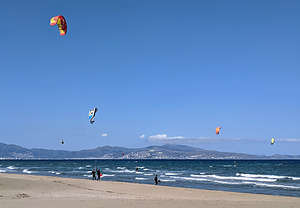 La Gaviota beachToday, after our two day dip into France, we drove back down the coast into Spain to explore the Costa Brava area.
La Gaviota beachToday, after our two day dip into France, we drove back down the coast into Spain to explore the Costa Brava area.
We had selected Camping La Gaviota, in the small village of Sant Pere Pescador on the Costa Brava, as a base camp for the next couple of days, because of its proximity to two places we really wanted to see: the Salvador Dali Museum in Figueres and the lovely white village of Cadaques. The fact that it was right on a beautiful beach with miles of running paths into town certainly didn’t hurt either.
It was raining when we arrived, so we hung out in the van until it stopped long enough for us to take a stroll on the beach.
Day 1 - Salvador Dali Theater and Museum
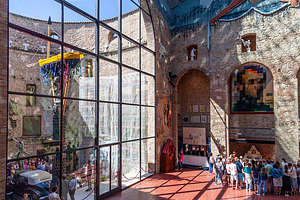 Is it Abraham Lincoln or Dali's beloved Gala (or both)? - zoom in closeThe next morning was very, very windy - similar to the conditions we experienced yesterday on the Narbonne Plage. We later found out that strong winds are very common this time of year on this part of the Mediterranean coast, making it a big draw for kite-surfers. In fact, the campground was full of Germans and Dutch people with trailers full of equipment to do just that. The stronger the wind, the happier they were.
Is it Abraham Lincoln or Dali's beloved Gala (or both)? - zoom in closeThe next morning was very, very windy - similar to the conditions we experienced yesterday on the Narbonne Plage. We later found out that strong winds are very common this time of year on this part of the Mediterranean coast, making it a big draw for kite-surfers. In fact, the campground was full of Germans and Dutch people with trailers full of equipment to do just that. The stronger the wind, the happier they were.
However, today we didn’t care about the wind, because we were heading into Figueres to visit the Salvador Dali Theater and Museum, which is actually the third most visited site in Spain (after the Prada and Bilbao’s Guggenheim). Knowing that, we had had the foresight to go online yesterday and buy tickets (https://www.salvador-dali.org/en/services/tickets/) for 12:30 today.
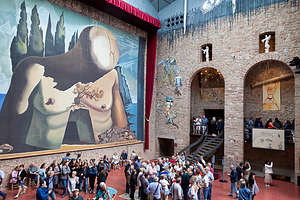 Courtyard of the Salvador Dali Theater and MuseumI think almost everyone is familiar with Dali’s surrealistic dream imagery paintings, such as Persistence of Memory, but there is so so much more to him than that. In fact, you won’t find that piece or many of his other more famous works here, as the top museums around the world have acquired them. However, the museum does contain a substantial portion of his life work.
Courtyard of the Salvador Dali Theater and MuseumI think almost everyone is familiar with Dali’s surrealistic dream imagery paintings, such as Persistence of Memory, but there is so so much more to him than that. In fact, you won’t find that piece or many of his other more famous works here, as the top museums around the world have acquired them. However, the museum does contain a substantial portion of his life work.
The museum itself is a work of art. In fact, it’s said to be the largest Surrealist art object in the world. Ever the showman, Dali designed it himself to be an all-round sensory and surreal experience, showcasing his life’s work. Everything about it exudes his outrageous public persona. The exterior of the building, which is painted pink, is studded with plaster-covered croissants, and the roof is topped with giant eggs and stylized Oscar-like figures. Unfortunately, renovations were being done, so scaffolding covered much of it.
When we entered the large courtyard, and the first stop on the tour, we were greeted with Dali’s personal 1941 Cadillac, called Rainy Taxi, because it rains inside it if a coin is deposited.
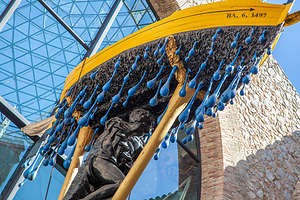 Dali’s boat, with blue tears made of condoms to express his grief for the loss of his soulmate and wife GalaHanging from the ceiling above his car is Dali’s boat, which he enjoyed using with his soulmate and wife Gala. His sadness upon her death is expressed by the blue tears made of condoms dripping from the bottom of it.
Dali’s boat, with blue tears made of condoms to express his grief for the loss of his soulmate and wife GalaHanging from the ceiling above his car is Dali’s boat, which he enjoyed using with his soulmate and wife Gala. His sadness upon her death is expressed by the blue tears made of condoms dripping from the bottom of it.
Meanwhile, surrounding the entire perimeter of the atrium are alcoves with life-size golden Oscar statues look down on the scene below. After all, this is not just a museum, but a theater as well.
On the second level there is a stage beneath which Dali is buried. To the left of the stage is a large portrait of his beloved Gala - or is it Abraham Lincoln. Well, it’s both. When you look straight at it, it appears to be a picture of a nude Gala looking at the Mediterranean Sea. If you squint, or look through the telescope at the end of the room, you will see a portrait of Abraham Lincoln instead. Her butt cheeks actually morph into Lincoln’s facial cheeks. At first I thought it was some kind of hologram, but it is actually an illusion created by layering multiple optical scales to create two paintings in one.
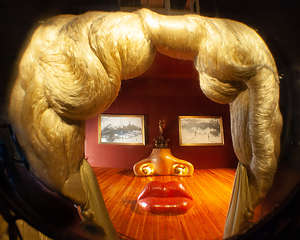 Mae West room with sofa lips, a fireplace nose, and two paintings for her eyes.Another one of our favorites was the Mae West Room. Dali admired her because she was as unconventional as he was, but morally rather than artistically. When we climbed up on the stairs in the room, we looked through a frame with blonde hair draped around it out to a room where a sofa was her lips, a fireplace her nose, and two paintings her eyes. It was really quite clever.
Mae West room with sofa lips, a fireplace nose, and two paintings for her eyes.Another one of our favorites was the Mae West Room. Dali admired her because she was as unconventional as he was, but morally rather than artistically. When we climbed up on the stairs in the room, we looked through a frame with blonde hair draped around it out to a room where a sofa was her lips, a fireplace her nose, and two paintings her eyes. It was really quite clever.
That’s just some of the highlights to be explored in the museum’s 22 exhibit rooms.
We spent the remainder of the day walking on the still windy beach and hanging by the campground pool. I even went for a 5-mile run (my first in Spain after weeks of lots of walking and hiking) into Sant Pere Pescador, a lovely old town with narrow winding alleys and a 14th century castle. On the way back, I ran along the River Fluvià to the beach.
The kiteboarders were still out there doing their thing zipping up and down along the shoreline. It looked so much fun!
Day 2 - Cadaques
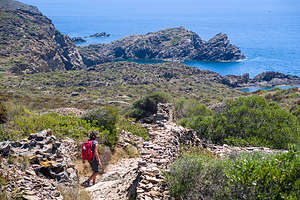 Along the Cap de Creus trailVisiting Cadaques was a bonus for us - the icing atop an already delicious cake. From the moment I started researching Spain and developing a tentative itinerary, I had set my sights on this lovely white fishing village by the sea. However, we didn’t know if we would have enough days left by the time we made it all around Spain and got here.
Along the Cap de Creus trailVisiting Cadaques was a bonus for us - the icing atop an already delicious cake. From the moment I started researching Spain and developing a tentative itinerary, I had set my sights on this lovely white fishing village by the sea. However, we didn’t know if we would have enough days left by the time we made it all around Spain and got here.
As disappointed as I was about not being able to hike in the Pyrenees because of the snow, it did give us the extra days to slip it in - not a bad consolation prize.
Although Cadaques was only 21 miles away, it took us close to an hour, because half of the drive was along a windy, nail-biting road with steep drop-offs. Very scenic for me, not so much for Herb as he had to keep his eyes glued to the road.
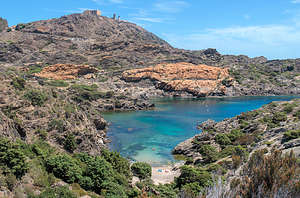 Lovely cove along the Cap de Creus trailWhen we got to the village it was easy to see why it is the most painted village in the world. What better recommendation could you get than from the likes of Picasso, Dali, Matisse, Miro, Man Ray, Magritte, and so many more artists. Much more relevant than a Trip Advisor review, although those were pretty good as well.
Lovely cove along the Cap de Creus trailWhen we got to the village it was easy to see why it is the most painted village in the world. What better recommendation could you get than from the likes of Picasso, Dali, Matisse, Miro, Man Ray, Magritte, and so many more artists. Much more relevant than a Trip Advisor review, although those were pretty good as well.
We passed by the village for now and drove out to Port Lligat and the trailhead for the 7.5 mile hike (out and back) to Cap de Creus, the easternmost point in Spain.
Also at Port Lligat is the Dali house, where he lived with his wife Gala from 1930 to 1982. Unfortunately, we were not able to get tickets to see the interior of the house, so we would just be hiking and visiting the village today.
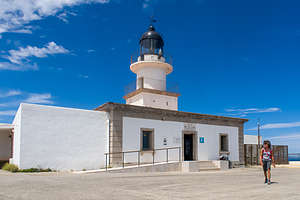 The Cap de Creus lighthouse - easternmost point in SpainThe trail led us up through old olive orchards before bringing us to astounding views out over the turquoise waters of horseshoe-shaped Cadaques Bay. For the next few miles we followed the trail up and down along a rocky ridge, with several tempting swimming coves down below. We would have to hit one of those on our way back.
The Cap de Creus lighthouse - easternmost point in SpainThe trail led us up through old olive orchards before bringing us to astounding views out over the turquoise waters of horseshoe-shaped Cadaques Bay. For the next few miles we followed the trail up and down along a rocky ridge, with several tempting swimming coves down below. We would have to hit one of those on our way back.
After about 3 ½ miles, we caught our first glimpse of the lighthouse at the highest point of the Cape and near its end - another ½ mile to go. Before we knew it, we were there, along with many others who had taken the easy way by car. There is a restaurant at the lighthouse, but we had packed a picnic lunch instead, which we planned to eat on one of those delightful coves.
Less than a half mile into our hike back, we took a small, rather steep path down to a very pretty cove where we could still see the lighthouse in the background. According to graffiti on a rock, this was a “platja nudista,” which even I with my limited Spanish could figure out. Still, like in any other beach in Spain, there was a whole range of amounts of clothing.
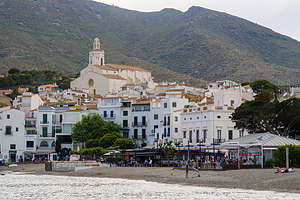 Cadaques - the most painted village in the worldRefreshed and relaxed, we made our way back to Port Lligat for a quick break before continuing on to the lovely white fishing village.
Cadaques - the most painted village in the worldRefreshed and relaxed, we made our way back to Port Lligat for a quick break before continuing on to the lovely white fishing village.
We walked past the Dali house, asking once again to no avail if there were any tickets available to go inside. We continued down to the harbor waterfront where all the action was - lots of people and plenty of fine restaurants and bars on the water. I would have loved to sit and sip a glass of wine at one of them, but there was that long windy road that we had to navigate back.
The many artists that came here to paint had excellent taste. The whitewashed buildings, craggy coastline, and turquoise waters glimmering in the evening light were absolutely stunning. Made me wish I could paint. Well, at least we had cameras.
We made it safe and sound back to Camping La Gaviota before nightfall.
Day 3 - Hanging out at La Gaviota
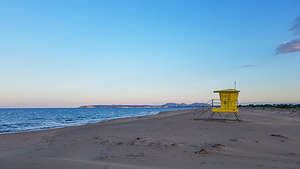 La Gaviota beachThis was a chill day. This campground and the beach were really world-class, so we decided to spend the day just enjoying it. Plus, the wind had died down, so we could spend time on the beach. An afternoon thunderstorm did chase us off the beach though.
La Gaviota beachThis was a chill day. This campground and the beach were really world-class, so we decided to spend the day just enjoying it. Plus, the wind had died down, so we could spend time on the beach. An afternoon thunderstorm did chase us off the beach though.
After it cleared, Herb went to the pool, and I went for Spain run #2 - a 5.5 miler, this time down the beach and along the River Fluvia into the village of Sant Pere Pescador and back.
That evening we had dinner on the terrace of the campground restaurant. I still can’t believe how wonderful campground restaurants are in Spain.
It was a nice way to start winding down our very long vacation.
Description
Camping La Gaviota is located in the small village of Sant Pere Pescador on the Costa Brava, right on the Playa de La Gaviota, a lovely wide sandy beach on the Costa Brava that is very popular with kitesurfers.
Besides its beautiful beach, it is a great base camp for visiting the Salvador Dali Museum in Figueres and the lovely white village of Cadaques.
Salvador Dali Theater and Museum
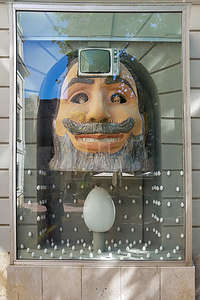 This must be the placeThe Salvador Dali Theater and Museum is a museum in Figueres designed by Dali himself to showcase his life’s works. The museum itself is a work of art. The exterior of the building, which is painted pink, is studded with plaster-covered croissants, and the roof is topped with giant eggs and stylized Oscar-like figures. Inside there are 22 exhibit rooms to explore, each of them exuding his outrageous public persona. It’s an all-round sensory and surreal experience. Some of the highlights include:
This must be the placeThe Salvador Dali Theater and Museum is a museum in Figueres designed by Dali himself to showcase his life’s works. The museum itself is a work of art. The exterior of the building, which is painted pink, is studded with plaster-covered croissants, and the roof is topped with giant eggs and stylized Oscar-like figures. Inside there are 22 exhibit rooms to explore, each of them exuding his outrageous public persona. It’s an all-round sensory and surreal experience. Some of the highlights include:
Dali’s personal 1941 Cadillac, called Rainy Taxi, because it rains inside it if a coin is deposited.
Hanging from the ceiling above his car is Dali’s boat, which he enjoyed using with his soulmate and wife Gala. His sadness upon her death is expressed by the blue tears made of condoms dripping from the bottom of it. Meanwhile, surrounding the entire perimeter of the atrium are alcoves with life-size golden Oscar statues look down on the scene below.
On the second level there is a stage beneath which Dali is buried. To the left of the stage is a large portrait of his beloved Gala - or is it Abraham Lincoln. Well, it’s both. When you look straight at it, it appears to be a picture of a nude Gala looking at the Mediterranean Sea. If you squint, or look through the telescope at the end of the room, you will see a portrait of Abraham Lincoln instead. Her butt cheeks actually morph into Lincoln’s facial cheeks.
The Mae West Room, where we looked through a frame with blonde hair draped around it out to a room where a sofa was her lips, a fireplace her nose, and two paintings her eyes. It was really quite clever.
It is the third most visited site in Spain (after the Prada and Bilbao’s Guggenheim), so buying tickets ahead of time is essential: (https://www.salvador-dali.org/en/services/tickets/)
Cadaques
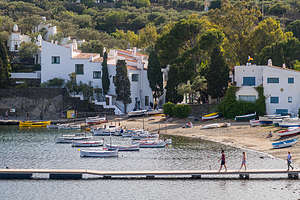 Port Lligat in CadaquesLovely white village, which is the most painted village in the world. Artists such as Picasso, Dali, Matisse, Miro, Man Ray, Magritte, and many more found the whitewashed buildings, craggy coastline, and turquoise waters glimmering in the evening light absolutely stunning.
Port Lligat in CadaquesLovely white village, which is the most painted village in the world. Artists such as Picasso, Dali, Matisse, Miro, Man Ray, Magritte, and many more found the whitewashed buildings, craggy coastline, and turquoise waters glimmering in the evening light absolutely stunning.
Past the village is Port Lligat and the Dali house, where he lived with his wife Gala from 1930 to 1982. Today it is a museum, but tickets must be purchased well in advance.
Also at Port Lligat is the trailhead for the 7.5 mile hike (out and back) to Cap de Creus, the easternmost point in Spain. The trail goes through old olive orchards and along a craggy ridge with awesome views the turquoise waters of horseshoe-shaped Cadaques Bay and its many lovely swimming coves. The turnaround point is the lighthouse, at the easternmost point of Spain.
The drive to Cadaques is along a windy, nail-biting road with steep drop-offs. However, it is worth every bit of anxiety along the way.
- ‹ previous
- 18 of 20
- next ›
Costa Brava - La Gaviota, Salvador Dali Theater and Museum, and Cadaques location map in "high definition"
Javascript is required to view this map.
